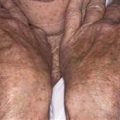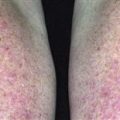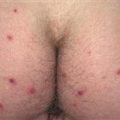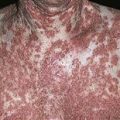56
Genital herpes simplex
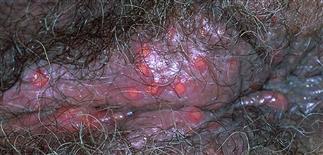
Primary herpes simplex lesions transform from vesicles and pustules to grouped erosions on a red base.

Large, painful ulceration with inflamed red border and surrounding small grouped vesicles consistent with herpes simplex.
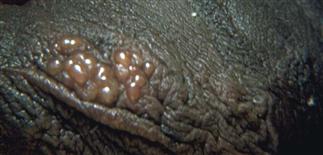
The classic presentation of early recurrent herpes with a group of vesicles of uniform size. A prodrome of ching or pain is commonly reported.

Recurrent herpes. Vesicles have evolved to form erosions on a red base. The patient reported that similar lesions had been present in the same location on other occasions.
DESCRIPTION
Genital herpes simplex is a common sexually transmitted disease caused by the herpes simplex virus (HSV). Primary painful vesicular infection is followed by recurrent outbreaks.
HISTORY
• Primary infection occurs 2–20 days after exposure; influenza-like symptoms, fever, headache, malaise, myalgia occur. In 3–4 days, vesicles develop. Tender lymphadenopathy occurs in the second and third weeks. • With recurrent infection, influenza-like symptoms are less intense or absent. A chronic, relapsing course is common. • Genital HSV transmission occurs via sexual contact; however, some cases can be transmitted by people who are unaware that they have the infection or are asymptomatic when transmission occurs.
PHYSICAL FINDINGS
• Primary infection symptoms are more severe and extensive than secondary infections. • Herpes simplex presents with a red swollen plaque followed by grouped vesicles that evolve into pustules and are surrounded by a red edematous base. The pustules rupture or break, may crust, and form shallow painful erosions. Large confluent erosions and ulcers can occur. • Lesions heal in 1–2 weeks. Hypopigmentation, hyperpigmentation, and sometimes scars may be left behind. • Lymphadenopathy (painful) occurs with primary infection.
TREATMENT
• Currently, there is no permanent cure for herpes simplex. • Explains the natural history of the disease, recurrent episodes, asymptomatic viral shedding, and sexual transmission. • Systemic antiviral drugs partially control symptoms and signs of herpes eruptions. These drugs neither eradicate latent virus nor affect the risk, frequency, or severity of recurrences after the drug is discontinued. • Initiate treatment within 72 h of onset of signs and symptoms. Valacyclovir, famciclovir, and acyclovir can be given orally and work best when given within 72 h of onset of symptoms. • Cool, wet, water compresses may suppress inflammation. • Severe primary infections can be treated intravenously for immunocompromised patients if needed. • Recurrent infection can be treated similarly as above. • Long-term suppressive therapy with lower doses of valacyclovir, famciclovir, acyclovir can be very helpful. Treatment is continued for at least 6–12 months. If treatment is successful, a trial without medication may be considered. Daily suppressive therapy reduces the frequency of genital herpes recurrences by at least 75% among patients who have six or more recurrences per year. Suppressive treatment reduces but does not eliminate asymptomatic viral shedding.


